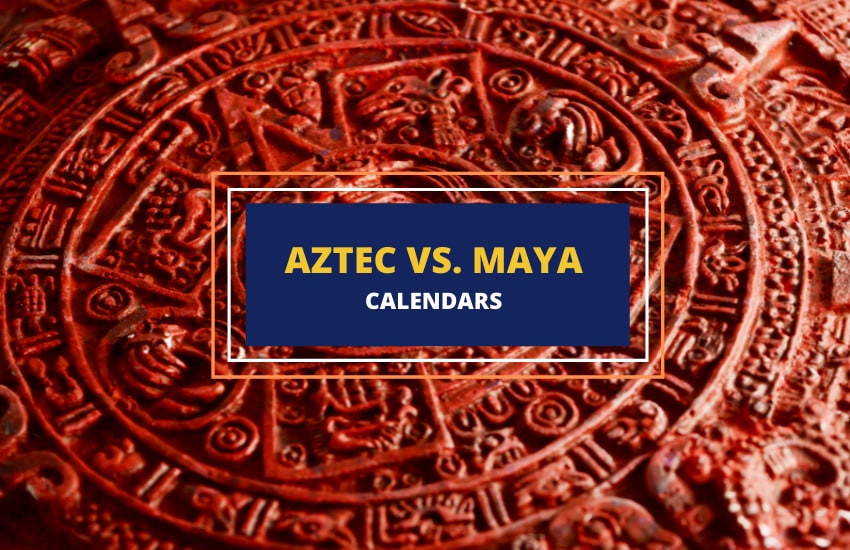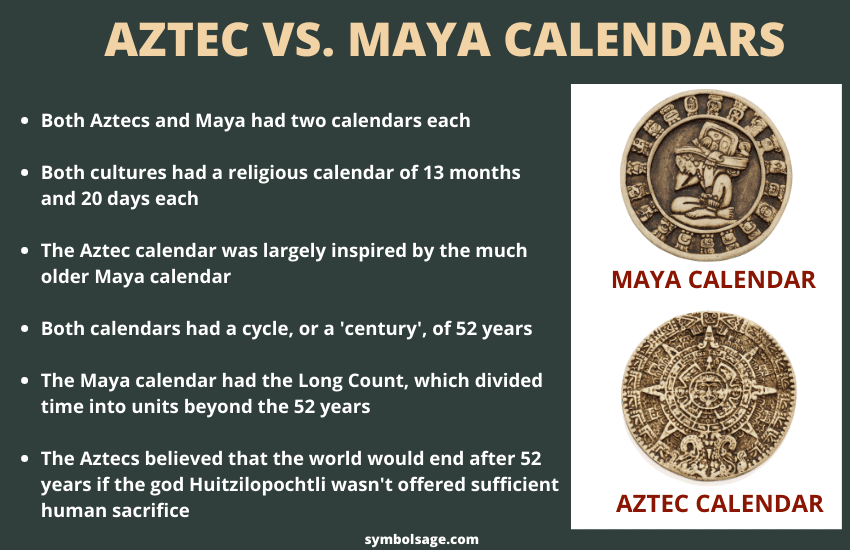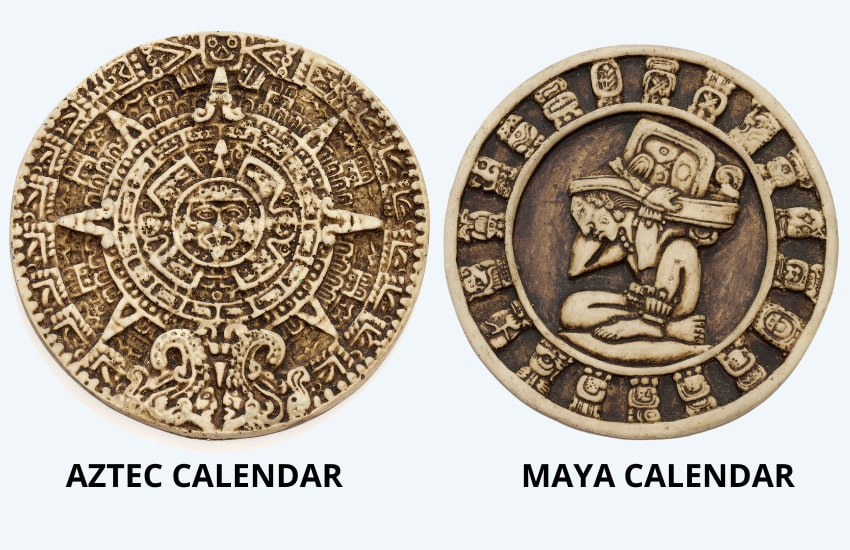
The Aztec and Maya people are the two most famous and influential Mesoamerican civilizations. They shared many similarities as they both were established in Central America, but they were also different in many ways. A prime example of this differences comes from the famous Aztec and Maya calendars.
The Aztec calendar is believed to have been influenced by the much older Maya calendar. The two calendars are almost identical in some ways but have a few key differences that distinguish them.

Who Were The Aztec and The Maya?
The Aztec and the Maya were two entirely different ethnicities and people. The Maya civilization has been a part of Mesoamerica since before 1,800 BCE – nearly 4,000 years ago! The Aztecs, on the other hand, migrated into Central America as late as the 14th century AD from the area of today’s Northern Mexico – just two centuries before the arrival of the Spanish conquistadors.
The Maya were still around at that time as well, even though their once-mighty civilization had begun to deteriorates. Ultimately, both cultures were conquered by the Spanish in the early 16th century just as they were starting to interact with each other.
Despite one civilization being so much older than the other, the Aztecs and the Maya had much in common, including many cultural and religious practices and rituals. The Aztecs had conquered much of other Mesoamerican cultures and societies on their march south, and they adopted many of these cultures’ religious rituals and believes.
As a result, their religion and culture change quickly as they spread through the continent. Many historians credit this cultural development as the reason why the Aztec calendar looks so much like that of the Maya and the other tribes of Central America.
Aztec vs. Maya Calendar – Similarities

Even if you know nothing about the Aztec and Maya cultures and religions, their two calendars are very similar even just at a glance. They are unique compared to calendrical systems elsewhere in the world in that each calendar is made out of two different cycles.
The 260-Day Religious Cycles – Tonalpohualli / Tzolkin
The first cycle in both calendars consisted of 260 days, divided into 13 months with each month being 20 days long. These 260-day cycles had almost purely religious and ritualistic significance, as they didn’t correspond to the seasonal changes of Central America.
The Aztecs called their 260-day cycle Tonalpohualli, while the Mayans called theirs Tzolkin. The 13 months were numbered from 1 to 13 instead of named. The 20 days in each month, however, had named corresponding to certain natural elements, animals, or cultural objects. This is opposite to the European practice of numbering the days and naming the months.
Here’s how the days in the Tonalpohualli / Tzolkin cycles were named:
| Aztec Tonalpohualli day name | Mayan Tzolkin day name |
| Cipactli – Crocodile | Imix – Rain and Water |
| Ehecatl – Wind | Ik – Wind |
| Calli – House | Akbal – Darkness |
| Cuetzpallin – Lizard | Kan – Maize or harvest |
| Coatl – Serpent | Chicchan – Heavenly Serpent |
| Miquiztli – Death | Cimi – Death |
| Mazatl – Deer | Manik – Deer |
| Tochtli – Rabbit | Lamat – Morning star / Venus |
| Atl – Water | Muluc – Jade or raindrops |
| Itzcuintli – Dog | Oc – Dog |
| Ozomahtli – Monkey | Chuen – Monkey |
| Malinalli – Grass | Eb – Human skull |
| Acatl – Reed | B’en – Green maize |
| Ocelotl – Jaguar | Ix – Jaguar |
| Cuauhtli – Eagle | Men – Eagle |
| Cozcacuauhtli – Vulture | Kib – Candle or wax |
| Ollin – Earthquake | Caban – Earth |
| Tecpatl – Flint or fling knife | Edznab – Flint |
| Quiahuitl – Rain | Kawac – Storm |
| Xochitl – Flower | Ahau – Sun God |
As you can see, the two 260-day cycles share several similarities. Not only are they constructed in the exact same way but even many of the day names are identical, and seem to have just been translated from the Mayan language to Nahuatl, the language of the Aztecs.
The 365-Day Agricultural Cycles – Xiuhpohualli/Haab
The other two cycles of both the Aztec and Mayan calendars were called Xiuhpohualli and Haab respectively. Both were 365-day calendars, making them as astronomically accurate as the European Gregorian calendar and others used around the world to this day.
The 365-day cycles of the Xiuhpohualli/Haab didn’t have any religious or ritualistic use – instead, they were meant for all other practical purposes. As these cycles followed the seasons, both the Aztecs and the Mayans used them for their agriculture, hunting, gathering, and other tasks dependant on the seasons.
Unlike The Gregorian calendar, however, the Xiuhpohualli and Haab calendars weren’t divided into 12 months of ~30 days each, but into 18 months of precisely 20 days each. This meant that every year, the two cycles had 5 leftover days that weren’t part of any month. Instead, they were dubbed “unnamed” days and were considered unlucky in both cultures as they weren’t devoted to or protected by any god.
As for leap day or leap year – neither the Xiuhpohualli nor the Haab had such a concept. Instead, the 5 unnamed days simply continued for some 6 extra hours until the first day of the new year could begin.
Both the Aztec and the Mayans used symbols to mark the 20 days in each of the 18 months in their calendars. As with the Tonalpohualli/Tzolkin 260-day cycles above, these symbols were of animals, gods, and natural elements.
The 18 months themselves also had similar but different names in the Xiuhpohualli / Haab 365-day cycles. They went as follows:
| Aztec Xiuhpohualli Month Name | Mayan Haab Month Name |
| Izcalli | Pop or K’anjalaw |
| Atlcahualo or Xilomanaliztli | Wo or Ik’at |
| Tlacaxipehualiztli | Sip or Chakat |
| Tozoztontli | Sotz |
| Hueytozoztli | Sek or Kaseew |
| Toxacatl or Tepopochtli | Xul or Chikin |
| Etzalcualiztli | Yaxkin |
| Tecuilhuitontli | Mol |
| Hueytecuilhuitl | Chen or Ik’siho’m |
| Tlaxochimaco or Miccailhuitontli | Yax or Yaxsiho’m |
| Xocotlhuetzi or Hueymiccailhuitl | Sak or Saksiho’m |
| Ochpaniztli | Keh or Chaksiho’m |
| Teotleco or Pachtontli | Mak |
| Tepeilhuitl or Hueypachtli | Kankin or Uniiw |
| Quecholli | Muwan or Muwaan |
| Panquetzaliztli | Pax or Paxiil |
| Atemoztli | K’ayab or K’anasily |
| Tititl | Kumk’u or Ohi |
| Nēmontēmi (5 unlucky days) | Wayeb’ or Wayhaab (5 unlucky days) |
The 52-Year Calendar Round
As both calendars consist of a 260-day cycle and a 365-day cycle, both also have a 52-year “century” called a “calendar round”. The reason is simple – after 52 of the 365-day years, the Xiuhpohualli/Haab and Tonalpohualli/Tzolkin cycles re-align with each other.
For every 52 of the 365-day years in either calendar, 73 of the 260-day religious cycles pass as well. On the first day of the 53rd year, the new calendar round begins. Coincidentally, this was more or less the average (slightly above average) lifespan of people.
To make matters a bit more complicated, both the Aztecs and the Maya counted those 52 calendar years not just with numbers but with combinations of numbers and symbols that would be matched up in various ways.
While both the Aztec and the Maya had this cyclical concept, the Aztec definitely put much more emphasis on it. They believed that at the end of every cycle, the sun god Huitzilopochtli would battle his brothers (the stars) and his sister (the moon). And, if Huitzilopochtli hadn’t received enough nourishment from human sacrifices over the 52-year cycle, he would lose the battle and the moon and stars would destroy their mother, the Earth, and the Universe would have to start anew.
The Mayans didn’t have such a prophecy, so, for them, the 52-year calendar round was just a period of time, similar to what a century is to us.
Aztec vs. Maya Calendar – Differences
There are several minor and superfluous differences between the Aztec and Maya calendars, with most of them being a bit too detailed for a quick article. However, there’s one major difference that should be mentioned and that perfectly exemplifies the main difference between the Maya and the Aztecs – scale.
The Long Count
This is one major concept that is unique to the Mayan calendar and that isn’t present in the Aztec calendar. Simply put, the Long Count is the calculation of time beyond the 52-year calendar round. The Aztecs didn’t bother with that because their religion compelled them to focus solely on the end of each calendar round – everything beyond that might as well not exist as it was threatened by Huitzilopochtli’s possible defeat.
The Mayans, on the other hand, not only didn’t have such a handicap but were also much better astronomers and scientists. So, they planned out their calendars for thousands of years in advance.
Their units of time included:
- K’in – a day
- Winal or Uinal – a 20-day month
- Tun – an 18-month solar calendar year or 360 days
- K’atun – 20 years or 7,200 days
- Calendar round – a 52-year period that re-aligns with the 260-day religious year or 18,980 days
- B’ak’tun – 20 k’atun cycles or 400 tuns/years or ~144,00 days
- Piktun – 20 b’aktun or ~2,880,000 days
- Kalabtun – 20 piktun or ~57,600,000 days
- K’inchiltun – 20 kalabtun or ~1,152,000,000 days
- Alautun – 20 k’inchltun or ~23,040,000,000 days
So, to say that the Mayans were “forward thinkers” would be an understatement. Granted, their civilization only survived about half a piktun (~3,300 years between 1,800 BC and 1,524 AD) but that’s still much more impressive than almost all other civilizations in the world.
If you’re wondering why people were so scared that the world would end on December 21, 2012 “according to the Mayan calendar” – it’s because even in the 21st century people still had trouble reading the Maya calendar. All that happened on Dec 21, 2012, was that the Mayan calendar moved into a new b’ak’tun (labeled as 13.0.0.0.0.). For reference, the next b’ak’tun (14.0.0.0.0.) is going to start on March 26, 2407 – it remains to be seen if people will freak out then too.
To recap, the Aztecs quickly adopted the 2-cycle calendar of the Mayans, but they didn’t have time to take the long-term aspect of the Mayan calendar. Also, given their religious fervor and focus on the 52-year calendar round, it’s not clear if or when they would have ever adopted the Long Count even if the Spanish conquistadors hadn’t arrived.
Wrapping Up
The Aztec and the Maya were two of the greatest civilizations of Mesoamerica and shared many similarities. This can be seen in their respective calendars, which were very similar. While the Maya calendar was much older and likely influenced the Aztec calendar, the latter was able to create a dis








